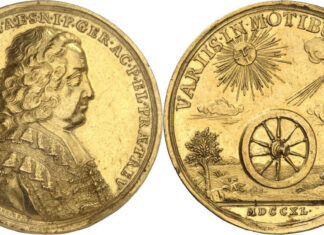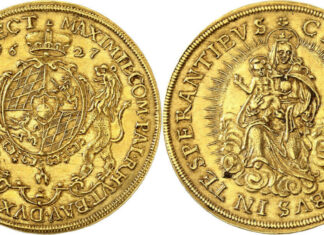Tag: Germany (Modern Period)
Mainz and the 1742 Imperial Election – An Archbishop Caught Between the Fronts
1740: a magnificent medal of the Archbishop of Mainz stresses his steady political course. But then came 20 October 1740, triggering consequences at the European level that put Mainz in an extremely difficult position.
Gate Tokens: Relics of Nuremberg’s History
Only on rare occasions can we link a numismatic object to a specific person. Regarding Nuremberg gate tokens, this is possible. We know whose hands touched them. Three of these tokens are on offer at Künker’s Fall Auction Sales. We tell their story.
An Unwilling Victor: Maurice of Saxony and the Schmalkaldic League
On 20 June 2022, the auction house Künker will be auctioning the first part of the Dr. Walter Kemlein Collection “Saxonia in Nummis”. It includes a double taler depicting the leaders of the Schmalkaldic League, among them Maurice of Saxony, who would have preferred not to be seen in this context.
What Can Really BIG Money Teach Us About Our World?
Really big pieces of money have often been treated as “curiosities” and overlooked in favor of shiny gold coins and crisp modern banknotes. As the stars of a new exhibition in the Smithsonian, they will do the heavy lifting as curator Ellen Feingold explains.
Germany’s False Start: The Unsuccessful Imperial Election of 1849
The German Constitutional National Assembly at St Paul’s Church in Frankfurt was one of the greatest achievements of the German revolutions of 1848. On 28 March 1849, the assembly elected Frederick William IV as Emperor of a unified Germany. Too bad that he did not want to be German Emperor in the first place!
Why the Munich Marienplatz Is Called Marienplatz
Our cities have evolved through history, and every architectural detail is connected to this history. We explain why the Munich Schrannenplatz (Grain Market Square) was renamed Marienplatz (Mary’s Square), using coins that will be on offer at Künker’s 2022 January Auction Sales as illustrations.
Who Was Frederick the Wise?
We all think we know him: Frederick the Wise who hid Luther at Wartburg Castle to protect him from imperial reprisals. As part of the Köhlmoos Collection, Künker will offer some coins featuring his portrait on 26 January 2022 that help us look beyond the myth.
When Cologne Almost Became Calvinist
In 1582, the Archbishop of Cologne converted to the Reformed faith. Not for religious reasons but because he wanted to marry his beloved. This triggered a war. In its anniversary auction 350, Künker offers a 2 1/2 taler piece of this bishop.
Finally – Or: Duke Augustus Celebrates His Birthday
Lösers were more than representative coins. They played an essential role in court ceremonials that took place on special occasions. The löser rarities of the Friedrich Popken Collection, which will be auctioned off at Künker on 29 June 2021, illustrate this function.
Joachim I: The Power-Conscious Elector Who Minted the First Brandenburg Taler
We are back in 1521: Luther stands in Worms and can do no other and the elector of Brandenburg mints the first talers of Brandenburg history. 500 years after it was minted, Künker offers one specimen of the extremely rare talers. We tell its story.












